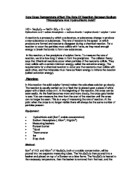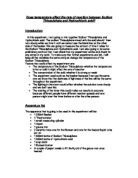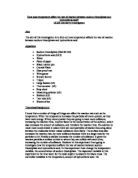How does temperature affect the rate of reaction between sodium thiosulphate and hydrochloric acid?
Emma Lazarus - 10Y1 - 10/PLR
Temperature and Rate of Reaction
Question
How does temperature affect the rate of reaction between sodium thiosulphate and hydrochloric acid?
sodium thiosulphate + hydrochloric acid › sodium chloride + water + sulphur dioxide + sulphur
Na2S2O3(aq) + 2HCl(aq) › 2NaCl(aq) + H2O(l) + SO2(aq) + S(s)
Prediction
I predict that the higher the temperature, the more quickly reaction will occur. This is because with heat, the particles of sodium thiosulphate and hydrochloric acid have more energy. This causes them to move around more. It works like this for all substances, not just those two. Chemical reactions require collisions, and if particles are moving around more quickly they are obviously more likely to collide. It is just like in a crowded street. If the people are moving quickly it is more likely that they will bump into each other then if they are moving slowly. It is in this way that particles of solutions react.
I found out from preliminary research that the particle theory explains that chemical reactions require a collision between the particles of the reactants, at a certain velocity and angle. If this angle or velocity is not achieved, the substances will not react together. I also found out that the factors that affect the rate of a reaction are the surface area of the solid reactant (if there is a solid reactant), the concentration of the aqueous reactant(s), the presence of catalysts and temperature. In this experiment we are only interested in temperature. Where temperature is not high enough to provide energy for the particles to move at a high enough speed, the particles will just not react, or rather, not as many particles will be able to react together in a certain amount of time.
At 0-10°C, I predict that the reaction will take a very long time to react. The reason I say this is because although the particles will be moving around, they will not be moving at a high enough velocity. For chemical reactions to occur, the particles must be travelling at a particular speed, and this requires energy. At this temperature I do not think that it will give the particles enough energy to convert into movement.
Between 11-40°C (this includes 3 temperature intervals - 11-20°C, 21-30°C and 31-40°C), I predict that the reaction will occur more quickly than that of 0-10°C. I think the reaction rate will decrease dramatically at this temperature. I predict this because there is more heat to provide energy to the particles of the reactants. This energy causes the particles (of sodium thiosulphate and hydrochloric acid) to move around more quickly, and naturally more collisions happen between the particles. Again a good thing to compare it to is people walking down the street, either quickly or slowly.
At the temperature of 41-70°C (again this is including 3 temperature intervals - 41-50°C, 51-60°C and 61-70°C), I predict that the reaction will occur even more quickly than that of 11-40°C. This is because by this time there is a lot of heat, which gives the particles of sodium thiosulphate and hydrochloric acid more energy, so they move around more quickly than before. Obviously, at a higher velocity the particles are going to be more likely to collide. Chemical reactions require collisions, and if the particles are more likely to collide then the reaction will occur faster. By ...
This is a preview of the whole essay
At the temperature of 41-70°C (again this is including 3 temperature intervals - 41-50°C, 51-60°C and 61-70°C), I predict that the reaction will occur even more quickly than that of 11-40°C. This is because by this time there is a lot of heat, which gives the particles of sodium thiosulphate and hydrochloric acid more energy, so they move around more quickly than before. Obviously, at a higher velocity the particles are going to be more likely to collide. Chemical reactions require collisions, and if the particles are more likely to collide then the reaction will occur faster. By these temperatures the reaction rate will have decreased dramatically.
Between 71-90°C (including 2 temperature intervals - 71-80°C and 81-90°C), I predict that the reaction will occur faster still than the ranges I have covered so far. This is because the particles will, by now, have a lot of energy from the heat, therefore moving around more, therefore colliding more - for the reaction to occur.
Finally, at 91-100°C, I think the reaction will occur almost immediately. I say this because the temperature is more or less high enough to boil water, and so the sodium thiosulphate and hydrochloric acid particles will be moving around extremely fast. There will be a LOT of collisions between the two sets of particles, causing a chemical reaction to occur.
So, to summarise, at a cold temperature the reaction will take more time to happen. This is because the particles of sodium thiosulphate and hydrochloric acid will not be moving around so quickly, meaning they are less likely to collide, therefore the reaction will take place in more time. Chemical reactions require a collision at a certain velocity, and if this velocity is not reached then the reaction will just not happen.
As the temperature increases, the reaction rate will be lower. This sis because with more heat, the particles have more energy, meaning they move around more. Collisions will be more likely to happen at a higher speed.
Results
Temperature range
(°C)
Actual temperature
(°C)
Time for cross to disappear
(s)
0-10
5
03
1-20
5
32
21-30
23
24
31-40
32
1
41-50
43
7
51-60
55
5
61-70
63
4
71-80
75
3
81-90
84
3
91-100
94
Graph
Conclusion
I conclude that the temperature does affect rate of reaction - the higher the temperature the lower the rate of reaction. I can see this from my table (the lowest temperature has the highest reaction time - 5°C took 103s - and the highest temperature has the quickest reaction time - 94°C took 1s). I can also see this from my graph. At the lower temperatures the line of best fit goes very high, and at the higher temperatures the line of best fit is very low.
This is because with more heat, the particles of sodium thiosulphate and hydrochloric acid have more energy. This causes them to move around more. Chemical reactions require collisions, and if two sets of particles are moving around quickly there will naturally be more collisions. However, the collisions require the particles to hit each other at a certain velocity, and if this velocity if not reached then the reaction will just not happen. So, at the higher temperatures, more of the particles were travelling at a high enough speed to collide and react. At the lower temperatures it was more difficult for the particles to collide. Only some were able to reach the required speed and react.
The particle theory says that for a chemical reaction to occur, there must be a collision at a certain velocity and at a certain angle. Also, the factors that affect the rate of a reaction are the surface area of the solid reactant (if there is a solid reactant), the concentration of the aqueous reactant(s), the presence of catalysts and temperature. In this experiment we were concentrating on temperature, and we were able to draw the conclusion that temperature does, in fact, affect the rate of a reaction, in that when the temperature is higher the reaction takes less time.
At 5°C the reaction took a very long time to occur. This was because there was not very much heat. Heat provides energy to the particles of reactants, and if there is not very much heat, the particles do not have very much energy. Because they do not have much energy they will not move around much, and will therefore not collide very often. Chemical reactions require a certain speed collision to react, and at this temperature very few of the particles collided, because of not moving around more due to lack of energy, because the heat was not very great.
Between 15-55°C the rate of reaction drops very dramatically. I can tell this from my graph, as the line of best fit goes down very steeply. This is because the heat has given the particles a little kick-start of energy, and they were able to move around a lot more than previously. The particles then collided more and reacted together.
Between 63-94°C, the time taken for the cross to disappear was going down a lot less quickly; in fact it almost comes to a halt, as you can see on the graph. This is because it is reaching the boiling point of water, and so the water in the solutions (as sodium thiosulphate and hydrochloric acid are aqueous solutions) starts to boil and turns to steam. So it is pretty much impossible to get to a higher temperature than 100°C. This is why the decrease of reaction rate slows - it got increasingly difficult for the solution to get hotter.
My results and evidence support my prediction very well. They prove the fact that temperature does affect the rate of reaction. I also have the particle theory to support my prediction and conclusion. My prediction was almost 100% correct, although I did not know that there would be a dramatic decrease in reaction rate on the lower temperatures. So I did make a good prediction, including as much as I could say without any evidence from an experiment.
Evaluation
The procedure used wasn't that suitable, in my opinion. We had groups of people, each doing the experiment for one temperature range. We can't possibly have all done the experiment in the same way, and this would mean some unreliable results. To improve the suitability of the procedure it would have to be done by the same person all the way through, using the same stopwatch. We would also have to take a lot more time over measuring out the sodium thiosulphate and hydrochloric acid, so this would be more accurate.
Also, as the temperature got higher, the results were closer together, and as we had to round the time in seconds to an integer they became less accurate. If we rounded the time more accurately (e.g. to 1 decimal place), our results would become more reliable. Another reason for the higher temperatures being very close together is that the water in the solutions was starting to boil, and therefore change state. If we increased the concentration of the Na2S2O3 and the HCl then our results would be slightly more accurate, because sodium thiosulphate and hydrochloric acid have higher boiling points and so the higher temperatures would not be so close. We would then be able to tell more easily how temperature affects reaction rate.
Another way of making our results more accurate would be to take multiple readings and then an average time from these. We didn't do this in our experiment because we did not have the time - had we the time we would have made sure we did this to make the results as accurate as possible. Because we didn't, our results were not nearly as accurate as we would have liked. You cannot really judge from 1 lot of results, because it's possible that something went wrong, or you timed incorrectly. It is quite difficult to judge properly the exact moment that the cross disappears - the human eye is just not strong enough. It is even more difficult for the higher temperatures as you would have to have an extremely good reaction time to stop the stopwatch exactly when the cross changes.
However, our results were consistent even though we did not take multiple results, because we only had one anomaly.
Concerning the amount of time taken for the cross to disappear, we could use a different method of working out how long the reaction took to occur. For example, we could shine a torch through the conical flask, and as soon as the light cannot shine through any more, we would stop the stopwatch.
We found that there was one anomalous result. It is shown on my graph. The reason for this could be that it was timed wrong. Because it was such a low temperature, it took a very long time for the cross to disappear (103 seconds). This meant that it was very difficult to judge the exact moment that it disappeared, as it would have been gradually changing. That could have been misjudged. For all of the results, it was very difficult to start the stopwatch exactly at the same the sodium thiosulphate and hydrochloric acid were put together. They would have already started reacting before the stopwatch was started.
Another possibility for the anomaly is that there was some other factor affecting the reaction rate. The four factors that affect the rate of a reaction are the surface area of the solid reactant (if there is a solid reactant), the concentration of the aqueous reactant(s), the presence of catalysts and temperature. In our experiment the dependant variable was temperature, and if the concentration of one of the solutions had changed for some reason (e.g. if some water was splashed onto it) then the experiment would not be a fair test.
For further work to our experiment, we could perform the experiment in a vacuum, as then there would be no other factors that can affect our results, other than temperature, which is all we wanted to be the dependant variable.







